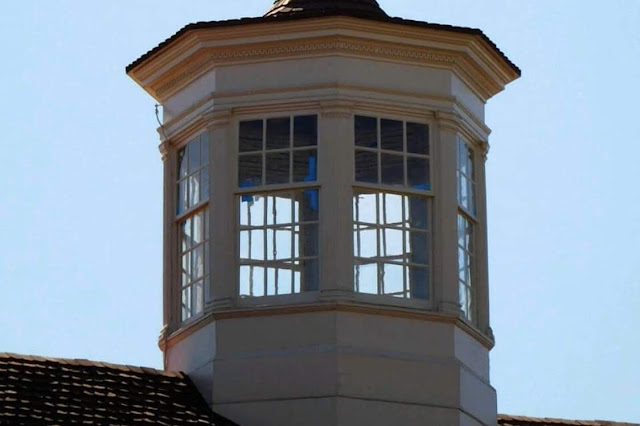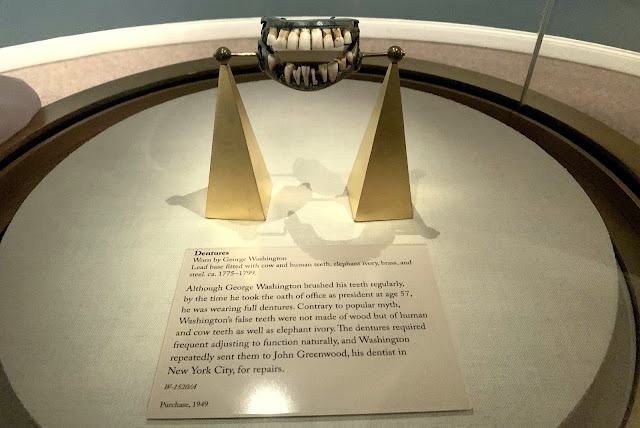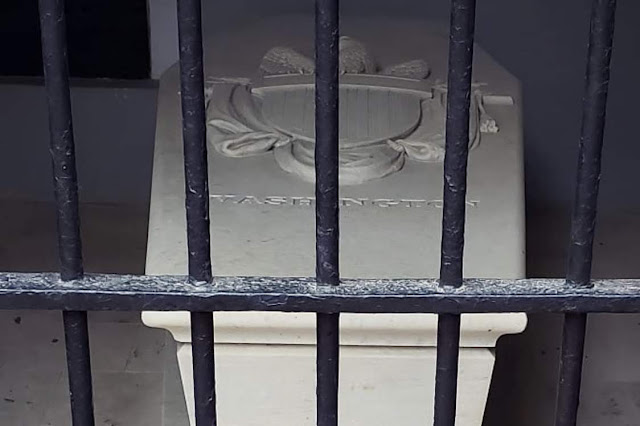 |
| "We all unite in offering you and yours the compliments of the Season, and the return of many, many more, and happy ones" -George Washington, Christmas 1797 |
Colonial Christmas, a celebration known as Twelfth Night, lasted from December 25 through the Epiphany, January 6. George and Martha Washington and their grandchildren would have attended Christmas service at Pohick Church and returned for a feast at Mount Vernon. Most slaves were given four days rest and small gifts, although cooks and dining servants would have still been made to perform their duties.
Visitor information can be found at Mount Vernon's main website.
The Mansion
George Washington's great-grandfather arrived in the colonies around 1674, and settled in the area along the Potomac River where the family estate, Mount Vernon, would be built in 1734. The home was expanded over the next half-century to become the 11,028 sq.ft. Palladian mansion which stands today.
Initially named the Little Hunting Creek Plantation, the estate became known as Mount Vernon after Vice Admiral Edward Vernon, under whom George's half-brother, Lawrence Washington, served in the British Navy. Mount Vernon remained in the Washington Family until 1858, when after several decades of decline and disrepair, the Mount Vernon Ladies Association purchased it for $200,000 (roughly $6M today), restored the mansion, and have been incredible caretakers of the estate ever since.
 |
| Bowling Green and Mansion |
 |
| The cupola and spire were of the final renovations to the mansion |
 |
| West colonnade |
 |
| Washington's view of the Potomac from the mansion's piazza |
 |
| Colonnade to Servants' Hall |
 |
| The Large Dining Room/New Room set for Christmas Dessert course |
 |
| Mantel and vases, a gift from Samuel Vaughan to Washington in 1785 |
 |
| Mantelpiece by Jeffereys Hamett O'Neale depicts Washington's agrarian vision for the new nation |
 |
| Displayed in the mansion's Passage, a key to the Bastille, a gift from General Lafayette and transmitted to the estate by Thomas Paine in 1790. |
 |
| The blue room and Martha's beautiful chinoiserie wallpaper |
 |
| Washington's study, with a portrait of Lawrence Washington, desk and chair originals from which Washington penned correspondence which shaped our new country |
 |
| Plaster profile by Joseph Wright |
 |
| Washington's vast collection of books, many in original binding |
Outbuildings
Aligning the mansion are the North and South Lanes of outbuildings to include a pantry, a wash house, stables, clerk's office, artisan's work stations, and slave's quarters. "Lady Washington" is a talented re-enactor hosting visitors and fielding questions from curious guests. She regaled us with the romantic tale of her first "interview" with George Washington, which she attributed to the "guiding hand of providence."
The Gardens
 |
| The Upper Gardens and Garden House |
The estate includes Lower, Upper, Fruit Gardens, Nursery, Greenhouse, and 12 acre field which are lovely in the Spring.
 |
| Fruit Garden and Nursery |
 |
| Aladdin the Christmas Camel |
In 1787, George Washington paid 18 shillings for a camel to be brought to Mount Vernon for his guests to see during Christmas. Every year, a camel returns during the Holiday season to continue the tradition.
Washington Family Tombs
 |
| Old Tomb |
Upon his death in 1799, Washington was initially buried in the Washington Family old tomb, but his remains (as well as the remains of Martha) were moved to a vestibule known as the New Tomb in 1837. Many in the United States Congress had moved to have the first President's remains interred in a crypt in the Capitol, but a Southern bloc in the House defeated the measure.
Pioneer Farm
The estate includes over 3000 acres of agricultural area aligning the banks of the Potomac River. A forest trail leads from the mansion to the wharf, and from the wharf paths lead to the batteau shed, 16-sided barn, fisheries, and farming outposts. Mount Vernon primarily produced tobacco, wheat, and hemp.
 |
| Animals on the Pioneer Farm |
 |
| Batteau Shed |
 |
| Sixteen-Sided Barn |
Wharf and Riverside
 |
| The Wharf |
Slave Memorial
In 1929, the Ladies' Association placed a stone marker at the burial place of some estimated 75 enslaved people, to include the remains of William Lee, Washington's most trusted valet. In 1983, an additional memorial site was added to the grounds in honor of the slaves who lived at Mount Vernon.
Visitor Center
The Visitor Center is just beautiful at Christmas. Colonial Chocolate makers give demonstrations of 18th century methods, and shops are full of gorgeous ornaments and gifts, all displayed on dozens of trees in the main atrium.
Museum and Education Center
 |
| 19 Year Old Washington with his original surveyor drafting tools |
The Mount Vernon museum is phenomenal. I have visited several times but this was my first to experience the 4D Revolutionary War 22 minute film in one of the center's several theaters. It was incredibly well done, as are the many installations throughout the tour. And of the many artifacts, George Washington's ivory dentures remain a favorite attraction of visitors. At $20, adult tickets provide access to the mansion, all grounds, museum, and educational center. Children under 5 are free. One can easily make a full day of all there is to see and learn at this wonderful site, brimming with proud American Heritage.
 |
| 45 year old General Washington astride his favored horse, Blueskin |
 |
| Washington's Dentures |
 |
| 57 year old Washington sworn in at his 1789 inauguration in New York |
Colonial Recipe: Christmas Wassail
Beginning around the 17th century, English in America carried on the Old Country tradition of "wassailing;" wassail from the Old English wass hael, or "be well." Colonists carried warm bowls of wassail door-to-door and sang carols in exchange for small gifts. This recipe comes courtesy of the Mount Vernon Ladies Association: Combine all ingredients and simmer over low heat (do not boil) for 20 minutes.
1 gallon apple cider
2 navel oranges
2 sliced lemons
2 cinnamon sticks
1 tsp. allspice
1.5 cups brown sugar
1 bottle white wine






























